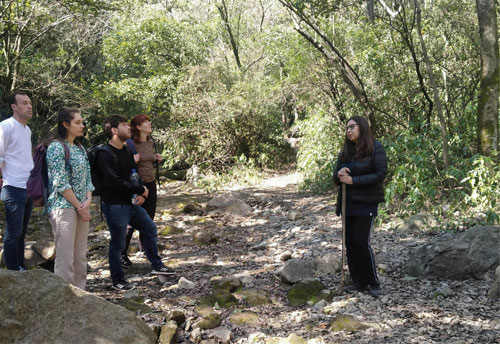20 camera traps installed inside Margalla Hills to monitor leopards’ movement
Zubair Qureshi
The Common Asian Leopard Preservation Zone inaugurated in Islamabad on January 1, 2022 by Prime Minister Imran Khan has proven a safe habitat to the critically endangered Asian leopards in Islamabad’s Margalla Hills National Park (MHNP).
Established in the Kalinjar area of Trail-6, just behind the Faisal Mosque, the 10-15 km radius zone is fenced and protected from public entry. The Islamabad Wildlife Management Board (IWMB) allows only a limited number of tourists, up to 20, for a guided tour.
This is done to maintain a healthy ecosystem and save the wild animals from frequent public interaction, said Rina Saeed Khan Chairperson of the IWMB, Sunday during a guided tour of the Trail-6. We would do everything we can to make sure these animals remain undisturbed and live in a natural environment, she said.
A number of German, French and local tourists and media persons were part of the visiting delegation.
Leopards are extremely shy animals and in order to ensure their privacy, we have declared the Trail-6 out of bounds for the general public, she said.
In doing so she has to face pressure from different circles to allow picnic, fun tours or family gatherings inside the trail but she has been resisting such pressure with the help of complete support from the Ministry of Climate Change.
The fact that Prime Minister Imran Khan announced the trail to be a ‘leopard preserved zone’ also helped her face and refuse all such ‘requests’ for opening the trail for commercial purpose or general public.
Those who wish to come to the site have to get registered a day prior to their visit. The IWMB also asks the visitors to make some contributions (Pak Rs1,000) per person so that camera traps, scientific gadgets or equipment could be procured to be installed along the trail.
In order to trace the leopards’ movement and to monitor their health and wellbeing, camera traps have been installed at different points, particularly the areas where they are frequently seen. The wildlife guards daily share an update about these elusive animals’ route and their previous night’s movement.
At present two male leopards (Sultan and Shehzada) and one female (Shehzadi) have been spotted constantly living inside the preserved zone, said Khan.
Trail-6 is home to not only the Asian leopards but around 38 species including rhesus monkeys, foxes, barking deer, snakes, jackals, pheasants, pangolin, porcupine and birds.
The preservation zone is in fact like a buffet for the leopards where they can enjoy a variety of animals for their supper. Unlike other trails, thankfully it is not adjacent to any populated areas or villages.
They are strictly territorial animals and have marked their areas by digging or spraying and only in the mating season, female leopards allow the male to visit her or they like to remain within their own territory. The IWMB has installed around 20 camera traps in the entire 17,000-hectare National Park, she informed and apart from our three leopards, a minimum of seven leopards had been captured by the camera, adding there were probably more of them there.
World Wide Fund (WWF) Pakistan has also installed a live camera trap with its own solar panel to provide uninterrupted power supply for monitoring the leopards’ movement. Besides, two leopard cats were also released inside the zone earlier this month, she said.The wildlife guard Asad said there were certain points where the leopards returned for sleep or drinking water after the hunt. There we have made it a point to install camera traps to get a clear picture.










